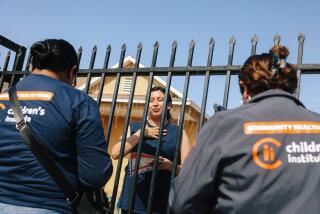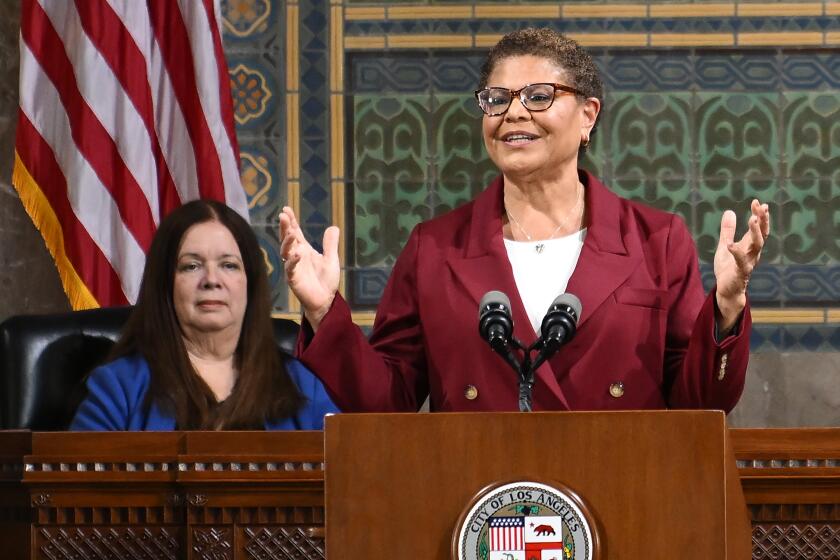Communication Gap : Culture Shock Hits Health Care
- Share via
The Mexican mother worries because the doctor issued a diagnosis for her baby without ever touching the child.
The Japanese patient believes that the doctor’s office staff is angry because of the atmosphere of brisk efficiency rather than welcoming politeness.
The elderly Korean woman’s family blames her stroke on nurses and doctors who upset her inner balance by treating her carelessly and then not noticing her quiet anger.
Such misunderstandings are becoming more common in Los Angeles and the rest of the nation as the United States rushes toward broader ethnic diversity. Cultural information gaps can develop into huge gulfs that prevent doctors from giving and their patients from getting the best possible medical care.
‘Good Communication’
“You can’t practice good medicine without good communication, and you can’t have good communication unless there is some understanding of the patient’s world view,” said Sylvia Drew Ivie, executive director of the T.H.E. Clinic for Women, which serves a multi-ethnic clientele in the Crenshaw district of Los Angeles.
“You can’t get the facts to diagnose the medical problem and you can’t get the trust and cooperation you need from the patient.”
Indeed, cultural barriers to conventional medical care are part of the reason that Latinos provide a willing clientele for unlicensed medical facilities throughout Southern California, said Ellen Pais, a deputy city attorney in Los Angeles who prosecutes unlicensed providers.
On Aug. 30, Pais is to begin trial in Los Angeles Municipal Court of some of the principals in a ring of allegedly bogus L.A. medical clinics, raided in June and accused of illegally serving 1,000 patients a week, most of them Latino.
Main Roadblocks
Pais and others involved in health care say the main roadblocks to good medical care for minorities are lack of money, health insurance and education, problems that are more likely to affect them than non-minority groups.
But even when free or low-cost health care is available, more subtle cultural barriers can make it harder for them to receive the full benefit of that care:
--Recent immigrants have health beliefs and medical expectations that can differ markedly from those of the dominant American medical system. These range from a Chinese traditionalist’s view of antibiotics as too powerful to some groups’ preferences for birth control methods that are regarded as unwise or unsafe in this country.
--The brusqueness of American medicine can alienate patients who come from cultures with strong customs regulating interactions between people. For instance, Latinas are put off if a medical visit doesn’t begin with chitchat, but Asians seek formal politeness.
--Accepted patterns of health behavior in a minority culture may be at odds with the American medical norm. So, a doctor who chastises someone for using a folk remedy or delaying medical care is both attacking the patient’s culture and wasting a chance to gently educate him.
--Intimidated by a medical system modeled on middle-class values and education, immigrants and the poor tend to be more passive about their approach to health professionals.
But the biggest problem with such generalizations about minorities and medical care is that they are generalizations, those who have worked in the field say. Groups differ from each other, and so do individuals.
Picture Not So Clear
Take language. It is self-evident that someone who doesn’t speak English at all needs to have a bilingual health facility or one with interpreters. But for someone who learned English as a second language, the picture is not so clear.
At Ivie’s nonprofit private clinic, she said, Latino patients frequently will not talk openly with or ask questions of an Anglo, even if that person is bilingual, because “they don’t want to impose,” Ivie said.
Thai clients generally want a Thai speaker, she said. Japanese, though, seem to prefer to interact with native English speakers, to demonstrate their proficiency in the language. And Korean women seeking gynecological help do not want a Korean health care worker, because they fear communication of private sexual matters within the close-knit Korean community.
Given this wide variety of reactions, the best approach health professionals can take to minorities is to have an open mind, said Susan Scrimshaw, a medical anthropologist at UCLA’s School of Public Health.
Value Judgments
“I spend all my time trying to explain people to doctors,” Scrimshaw said. “I spend a lot of my time trying to get people away from value judgments.”
She pointed out that Americans often look down on other cultures’ health values but ignore the fact that the dominant American culture has beliefs of its own, not all of them rational: the superiority of brown sugar and bread and the power of orange juice, for example.
Yet something as simple as the belief in orange juice becomes problematic in the face of the widespread folk medicine practice of balancing “hot” and “cold” in the body.
Latinos often believe, for instance, that someone with a fever should never be given cold liquids because it shocks the body.
“If a baby has a cold and you tell the mother to give the baby lots of juice, that is completely violating the hot and cold,” Scrimshaw said. “It’s simpler just to say give the baby liquids, and if it’s a warm liquid like chicken soup then it’s all right--because all you care about is getting liquids in.”
Crucial Advice
This kind of cultural flexibility makes it easier to get minority patients’ attention on advice that is more crucial, such as avoiding specific folk remedies that contain toxic ingredients or complying with special diets, Scrimshaw said.
The keys for health care workers are awareness and time, said Barbara Pillsbury, a medical anthropologist in Malibu who consults for a variety of international health agencies on Asian programs.
“Part of the reason that doctors and nurses are not as culturally sensitive as they could be or should be is because of their own insensitivity in many cases to cultural differences,” Pillsbury said.
“And in other cases it is because they are so pressed by time and all those other constraints,” she said. “Even if that physician is culturally sensitive, he may not have the time to sit down and do what is required to overcome those cultural barriers.”
She advises doctors to ask very specific questions of their Asian patients, repeating them in several different ways; to sit down to reduce the status difference between patient and doctor, and to approach a family member, not the patient, when there seem to be problems, thus allowing the patient to save face.
Among poor blacks, Ivie said, health care workers must remember that even though blacks do not face the same language or cultural barriers of immigrants, they commonly have serious problems finding medical care.
“Often there has been so much difficulty working through the system that a patient will come in who assumes she is not going to be treated well,” Ivie said. “There needs to be an awareness that hostility is not really a set opinion but a defensive posture.”
Overall, the nation’s two biggest minority groups, blacks and Latinos, have higher incidence of chronic diseases and their complications than do Anglos. Hypertension, coronary heart disease, certain types of cancer, diabetes and stroke are higher for them than the rest of the population. For example, blacks are twice as likely as Anglos to die of stroke, and the diabetes rate among Latinos is three times that of Anglos, according to federal figures.
Ignoring Early Symptoms
Poverty is seen as one direct reason for the disparity. But observers say that ignoring early symptoms of ill health can also be part of a community norm that doctors must recognize, even as they try to change it.
“There needs to be an appreciation that culturally there is not a whole history of preventive attention to health care, that it’s much more of a crisis approach, so you’re going to get black patients more at the end of the course of whatever it is, rather than at the beginning,” Ivie said. “But there also needs to be no judgment. Because if in fact that is the pattern in a wide proportion of the community, then it’s insensitive to scold a person as though they’re the aberrant one when that is the pattern.”
Mary Ann Lewis, a UCLA adjunct professor of medicine and nursing, points to her experience in studying how to train Latino children to recognize the signs of asthma attacks. Before the study could begin, she said, researchers had to persuade the children that wheezing wasn’t normal.
‘To Them That’s Normal’
“These kids have wheezed most of their lives, so to them that’s normal. Because they had never had any good relief, they had no perception of what really feeling good means,” Lewis said.
Dr. Aliza Lifshitz, a member of the California Hispanic American Medical Assn., said she believes that even educated Latinos whose families have been in the United States for generations put off getting medical care because they are not really reached by health education materials.
“It’s not only the language, it’s how they receive the messages,” Lifshitz said. “For the most part I would say that Latinos respond better to messages that are given in a language of feeling rather than the detached language of science. So a lot of times though the message is there and the language is there it does not really reach Hispanics in the same way.”
Similarly, health messages won’t get through if there is no recognition of the need for light conversation with Latinas, or if the doctor is unaware of their feeling that a physician must touch the patient to make an accurate diagnosis.
As Scrimshaw tries to make health professionals more sensitive to such subtle issues, she said, she finds herself amazed at the notion that some of these things have to be taught at all.
“In Latino culture, you have worth independent of your education and your income. You respect the doctor for his education and his knowledge, but the doctor should respect you for what you are,” she said. “If the doctor talks down to you or scolds you in front of other patients, that violates your dignity and then you lose respect for the doctor. And that happens all the time.
“So one of the things I try to work with the doctors on is the concept of human dignity and worth, and that human beings treat each other with respect.”
More to Read
Sign up for Essential California
The most important California stories and recommendations in your inbox every morning.
You may occasionally receive promotional content from the Los Angeles Times.













![Vista, California-Apri 2, 2025-Hours after undergoing dental surgery a 9-year-old girl was found unresponsive in her home, officials are investigating what caused her death. On March 18, Silvanna Moreno was placed under anesthesia for a dental surgery at Dreamtime Dentistry, a dental facility that "strive[s] to be the premier office for sedation dentistry in Vitsa, CA. (Google Maps)](https://ca-times.brightspotcdn.com/dims4/default/07a58b2/2147483647/strip/true/crop/2016x1344+29+0/resize/840x560!/quality/75/?url=https%3A%2F%2Fcalifornia-times-brightspot.s3.amazonaws.com%2F78%2Ffd%2F9bbf9b62489fa209f9c67df2e472%2Fla-me-dreamtime-dentist-01.jpg)